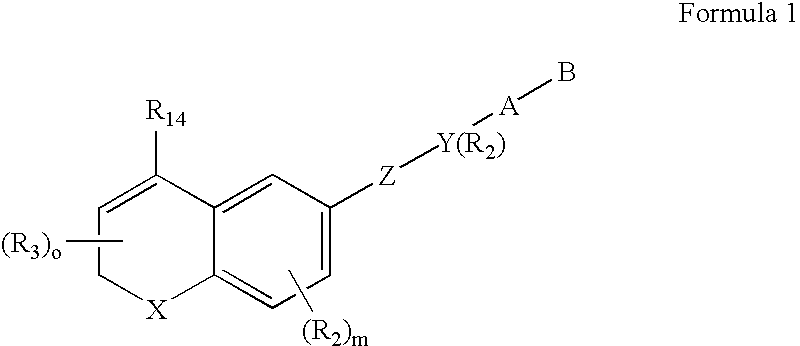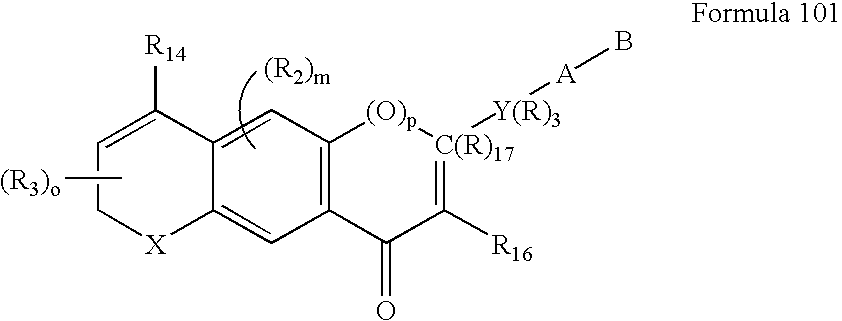Methods of identifying compounds having nuclear receptor negative hormone and/or antagonist activities
a nuclear receptor and antagonist technology, applied in the field of new compounds, can solve the problems of limiting the acceptability and utility of retinoids for treating diseases, the number of the so as to prevent or diminish the action of rar agonists, and prevent certain undesired side effects of retinoids
- Summary
- Abstract
- Description
- Claims
- Application Information
AI Technical Summary
Benefits of technology
Problems solved by technology
Method used
Image
Examples
example 1
Skin Iritation Induced by Topically Applied Agonist is Treated with Topically Applied Antagonist
[0127]The compound 4-[(E)-2-(5,6,7,8-tetrahydro-5,5,8,8-tetramethylnaphthalen-2-yl)propen-1-yl]benzoic acid, designated AGN 191183, is known in the prior art as a potent RAR agonist (see for example the descriptive portion and FIG. 2b of U.S Pat. No. 5,324,840). (The “AGN” number is an arbitrarily designated reference number utilized by the corporate assignee of the present invention for identification of compounds.)
[0128]4-[(5,6-dihydro-5,5-dimethyl-8-(phenyl)-2-naphthalenyl)ethynyl]benzoic acid (AGN 192869, also designated Compound 60a) is a compound the preparation of which is described below. This compound is an RAR antagonist.
[0129]Skin irritation induced by an RAR agonist, AGN 191183, administered topically, can be blocked by an RAR antagonist, AGN 192869, also administered topically in hairless mice.
[0130]More particularly skin irritation was measured on a semiquantitative scale by...
example 2
Skin Iritation Induced by Orally Applied Agonist is Blocked with Topically Applied Antagonist
[0139]The potent RAR agonist AGN 191183 (4-[(E)-2-(5,6,7,8-tetrahydro-5,5,8,8-tetramethylnaphthalen-2-yl)propen-1-yl]benzoic acid) and the potent RAR antagonist 4-[(5,6-dihydro-5,5-dimethyl-8-(4-methylphenyl)-2-naphthalenyl)ethynyl]benzoic acid (AGN 193109, Compound 60) were used in this example and body weight of the experimental animals (mice) was used as a marker of systemic RAR agonist exposure.
[0140]Groups of female hairless mice (8-12 weeks old, n=6) were treated by intragastric intubation with corn oil or AGN 191183 (0.26 mg / kg) suspended in corn oil (5 ml / kg). Mice were simultaneously treated topically on the dorsal skin with vehicle (97.6% acetone / 2.4% dimethylsulfoxide) or solutions of AGN 193109 in vehicle (6 ml / kg). Specific doses for the different treatment groups are given in Table 8. Treatments were administered daily for 4 consecutive days. Mice were weighed and graded for to...
example 3
Topically Applied Antagonist Accelarates Recovery from Prexisting Retinoid Toxicity
[0144]In this example, weight loss is induced by topical treatment with the RAR agonist AGN 191183 and then the test animals are topically treated with either vehicle or the RAR antagonist AGN 193109.
[0145]Female hairless mice (8-12 weeks old, n=5) were treated topically with AGN 191183 (0.13 mg / kg / d) in vehicle (97.6% acetone / 2.4% DMSO, 4 ml / kg) daily for 2 days. Groups of these same mice (n=5) were then treated topically either with vehicle or AGN 193109 in vehicle (4 ml / kg) daily for 3 consecutive days beginning on day 3. Mice were weighed on days 1-5 and on day 8. Body weights are expressed as the mean±SD. Means were compared statistically using an unpaired, two-tailed t-test. Differences were considered significant at P<0.05.
[0146]
TABLE 9Results, Example 3TreatmentBody Weight (g)(days 3-5)DAY 1DAY 2DAY 3DAY 4DAY 5DAY 8vehicle24.6 ± 1.523.9 ± 1.221.4 ± 1.220.3 ± 1.721.0 ± 1.424.7 ± 1.0AGN 19310923...
PUM
 Login to View More
Login to View More Abstract
Description
Claims
Application Information
 Login to View More
Login to View More - R&D
- Intellectual Property
- Life Sciences
- Materials
- Tech Scout
- Unparalleled Data Quality
- Higher Quality Content
- 60% Fewer Hallucinations
Browse by: Latest US Patents, China's latest patents, Technical Efficacy Thesaurus, Application Domain, Technology Topic, Popular Technical Reports.
© 2025 PatSnap. All rights reserved.Legal|Privacy policy|Modern Slavery Act Transparency Statement|Sitemap|About US| Contact US: help@patsnap.com



